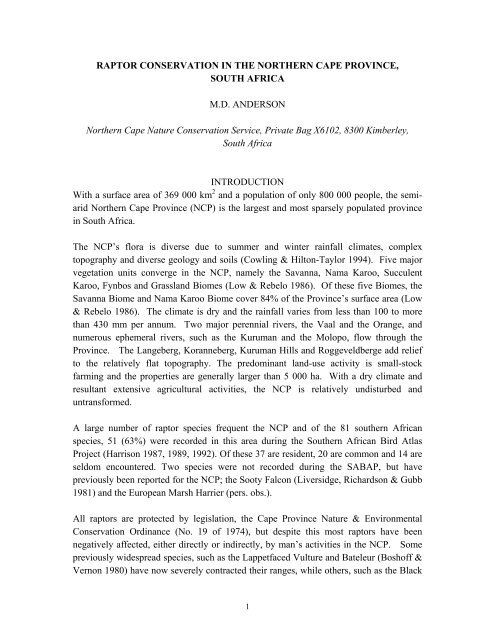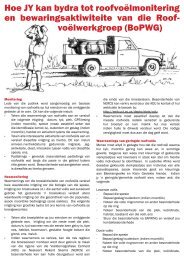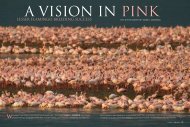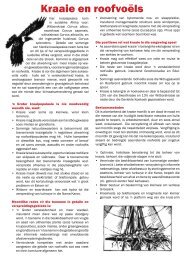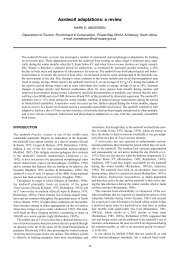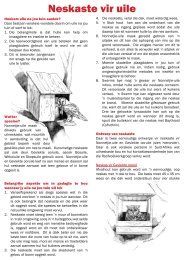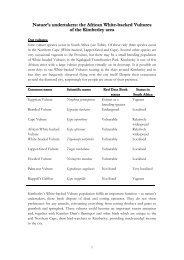raptor conservation in the northern cape province - Andersonafrica ...
raptor conservation in the northern cape province - Andersonafrica ...
raptor conservation in the northern cape province - Andersonafrica ...
You also want an ePaper? Increase the reach of your titles
YUMPU automatically turns print PDFs into web optimized ePapers that Google loves.
A total of 265 farmers who returned <strong>the</strong> <strong>raptor</strong> questionnaire reported that <strong>the</strong>y wereexperienc<strong>in</strong>g eagle stock depredations. The number of farmers who reported losses ofstock and game to <strong>raptor</strong>s is given <strong>in</strong> Table III and it is evident that <strong>the</strong> sheep and goatcategory (86.4% of total loss reports) is <strong>the</strong> most important. These depredations wereprimarily by <strong>the</strong> Black Eagle, Tawny Eagle and Martial Eagle (92.5%). Not a s<strong>in</strong>glefarmer reported any depredations by eagles of calves.Most farmers reported m<strong>in</strong>imal losses due to eagles, with only 74 of <strong>the</strong> farmers whoreported stock losses (27,9%) los<strong>in</strong>g more than 20 small livestock per annum (Table IV).The majority (93.9%) of <strong>the</strong> small-stock loss reports came from properties larger than2500 ha.Table III Number of farmers who reported eagle depredations of domestic stock, gameand poultrySheep Goats Calves Game Poultry Total %of totalBlack Eagle 99 47 0 8 3 157 59.2Tawny Eagle 24 12 0 6 4 46 17.4Martial Eagle 19 12 0 9 2 42 15.8Bateleur 9 5 0 1 0 15 5.7Unknown Eagle 2 0 0 1 2 5 1.9African Fish Eagle 0 0 0 0 0 0 0Total 153 76 0 25 11 265 100Table IV Number of farmers who reported that more than 20 small livestock (goat kidsand sheep lambs) units were lost due to eagle depredations per annum on <strong>the</strong>ir propertiesSheep Goats TotalBlack Eagle 33 13 46Tawny Eagle 12 3 15Martial Eagle 10 3 13Total 55 19 74The distribution of farmers who reported stock depredations by <strong>the</strong> Black, Martial andTawny Eagle co<strong>in</strong>cides with <strong>the</strong> various mounta<strong>in</strong> ranges (Langeberg and AsbestosMounta<strong>in</strong>s, and <strong>the</strong> mounta<strong>in</strong> ranges of <strong>the</strong> Karoo) and <strong>the</strong> Vanzylsrus area. These areasprovide suitable habitat for <strong>the</strong>se species and <strong>the</strong> Vanzylsrus area is a possible dispersalroute along <strong>the</strong> Shabe and Molopo Rivers for young <strong>raptor</strong>s from Botswana.8
Reservoir drown<strong>in</strong>gsThe drown<strong>in</strong>g of <strong>raptor</strong>s <strong>in</strong> circular farm reservoirs is believed to be a significantmortality factor <strong>in</strong> <strong>the</strong> NCP and thus far 18 species have been recorded to drown <strong>in</strong> <strong>the</strong>sestorage dams (Anderson unpubl. data; Anderson 1995a; Knight 1987; Maritz pers.comm.; Mundy, Butchart, Ledger & Piper 1992) (Table V).In arid areas, such as <strong>the</strong> Kalahari, <strong>raptor</strong>s rely to a greater extent on artificial water fordr<strong>in</strong>k<strong>in</strong>g and bath<strong>in</strong>g purposes, which is usually <strong>in</strong> <strong>the</strong> form of steep-walled concretereservoirs which are seldom full. It is believed that, while attempt<strong>in</strong>g to dr<strong>in</strong>k, <strong>the</strong>y fallor slip <strong>in</strong>to farm reservoirs and as <strong>the</strong> walls do not provide purchase for <strong>the</strong>m to climbout, <strong>the</strong>y eventually drown. The reasons for <strong>the</strong> mass drown<strong>in</strong>g of vultures, of which<strong>the</strong>re have been at least three recent <strong>in</strong>cidences <strong>in</strong> <strong>the</strong> NCP, is not clear (Anderson 1995,Knight 1987, Maritz pers. comm.). An example is <strong>the</strong> <strong>in</strong>cident dur<strong>in</strong>g January 1996when 38 Whitebacked Vultures drowned <strong>in</strong> a s<strong>in</strong>gle reservoir <strong>in</strong> <strong>the</strong> Kalahari. Massdrown<strong>in</strong>gs could be related to <strong>the</strong> <strong>in</strong>gestion of poisons. Alternatively, like feed<strong>in</strong>gactivity, which is normally triggered by <strong>the</strong> actions of one <strong>in</strong>dividual that releases <strong>the</strong>feed<strong>in</strong>g response <strong>in</strong> <strong>the</strong> group, it is suggested that bath<strong>in</strong>g too is a group activity,triggered by <strong>the</strong> first <strong>in</strong>dividual to enter <strong>the</strong> water.There are many simple and effective solutions to this problem (for example, Johnson1991; Anderson & Taljaard 1994a,b,c) and <strong>the</strong>se are currently be<strong>in</strong>g promoted dur<strong>in</strong>gfarmer extension programmes, through farmers magaz<strong>in</strong>es and newsletters, a televisionprogramme, and by means of a pamphlet.ElectrocutionThroughout <strong>the</strong> world electricity powerl<strong>in</strong>es pose a grave danger to <strong>raptor</strong> populations(e.g. Ferrer, de la Riva & Castroviejo 1991; Ledger & Annegan 1981). Raptors areusually killed when <strong>the</strong>y alight on <strong>the</strong>se "convenient" perches and death can be as a resultof a "phase-to-phase" or a "phase-to-earth" electrocution. In South Africa Eskom has anextensive electrification scheme, compris<strong>in</strong>g ma<strong>in</strong>ly of 11 kV and 22 kV l<strong>in</strong>es onwooden-pole structures, with 60 000 km of such l<strong>in</strong>es across rural terra<strong>in</strong> (Ledger,Hobbs & Smith 1993).In <strong>the</strong> NCP many <strong>raptor</strong> species have succumbed because of electrocution on <strong>the</strong>sepowerl<strong>in</strong>es. Recent records <strong>in</strong>clude <strong>the</strong> follow<strong>in</strong>g species: Tawny Eagle (Boshoff &Basson 1993), Martial Eagle (Boshoff & Basson 1993, Ledger et al. 1993), Black Eagle(Ledger et al. 1993), African Fish Eagle (pers. obs), Jackal Buzzard (Ledger et al. 1993),Whitebacked Vulture (Anderson & Kruger 1995), Lanner Falcon (pers. obs.) and PaleChant<strong>in</strong>g Goshawk (pers. obs).11
The Endangered Wildlife Trust’s Raptor Conservation Group has two projects <strong>in</strong> <strong>the</strong>NCP; one <strong>in</strong> <strong>the</strong> Karoo, <strong>the</strong> “Platberg Raptor Project” which is coord<strong>in</strong>ated by FrancoisTaljaard and and <strong>the</strong> o<strong>the</strong>r <strong>in</strong> <strong>the</strong> Kalahari, <strong>the</strong> “Kalahari Raptor Project”, coord<strong>in</strong>ated byAbrie Maritz. These projects <strong>in</strong>clude farmer extension and <strong>raptor</strong> monitor<strong>in</strong>g (roadcensus<strong>in</strong>g and nest monitor<strong>in</strong>g). The Nor<strong>the</strong>rn Cape Nature Conservation Service alsohas a farmer extension programme.Various conservancies are be<strong>in</strong>g established with <strong>the</strong> <strong>in</strong>tention of conserv<strong>in</strong>g birds ofprey. The "Molopo Raptor Conservancy", just outside <strong>the</strong> NCP, protects <strong>the</strong> Bateleur,Wahlberg’s Eagle, Whitebacked Vulture and o<strong>the</strong>r species which breed <strong>in</strong> <strong>the</strong> Molopoarea. The "Rooibergbewarea", when established, will protect <strong>the</strong> Black Eagle and BootedEagle (Anderson, Maritz & Anderson 1995) population and o<strong>the</strong>r smaller species whichoccur <strong>in</strong> <strong>the</strong> Asbestos Mounta<strong>in</strong>s. O<strong>the</strong>r conservancies are <strong>in</strong> <strong>the</strong> pipel<strong>in</strong>e: a conservancyaround Kimberley and a conservancy <strong>in</strong> <strong>the</strong> Kalahari, <strong>in</strong> <strong>the</strong> vic<strong>in</strong>ity of Severn.One of <strong>the</strong> more recent developments is <strong>the</strong> development of a "<strong>raptor</strong> tourist route"through <strong>the</strong> Kalahari. A pamphlet has been produced, which <strong>in</strong>cludes a map and detailsof <strong>the</strong> species which are likely to be seen along a specified route through this area. Oneof <strong>the</strong> ma<strong>in</strong> aims of this <strong>in</strong>itiative is to show <strong>the</strong> <strong>in</strong>habitants of <strong>the</strong> Kalahari that <strong>the</strong><strong>raptor</strong>s have a monetary value and by attract<strong>in</strong>g ecotourists to this area, valuable revenuewill be made available to bus<strong>in</strong>esses and entrepreneurs.ACKNOWLEDGEMENTSI am grateful to <strong>the</strong> farmers who returned questionnaire forms. Willem Swart, Mar<strong>in</strong>aBosch, Enrico Oosthuysen and Sharma<strong>in</strong>e Kruger provided technical assistance. AbrieMaritz, Francois Taljaard and Julius Koen provided unpublished data. This article isbased on <strong>the</strong> paper by Ron Hartley, Kit Hustler and Peter Mundy.REFERENCESALLAN, D.G. 1987. Raptors nest<strong>in</strong>g on transmission pylons. African Wildlife 42(6):325-327.ALLAN, D.G. 1989. Strychn<strong>in</strong>e poison and <strong>the</strong> <strong>conservation</strong> of avian scavengers <strong>in</strong> <strong>the</strong>Karoo, South Africa. S. Afr. J. Wildl. Res. 19(3): 102-106.ANDERSON, M.D. 1994a. First record of Sociable Weavers nest<strong>in</strong>g <strong>in</strong> an exotic tree.Bird<strong>in</strong>g <strong>in</strong> S.A. 47(1): 20.ANDERSON, M.D. 1994b. Mass African Whitebacked poison<strong>in</strong>g <strong>in</strong> <strong>the</strong> nor<strong>the</strong>rn Cape.Vulture News 29: 31-32.ANDERSON, M.D. 1994c. Land owners help conserve birds of prey. Farmer's WeeklyMay 13: 33-34.ANDERSON, M.D. 1994d. Bewaarders van roofvoels vereer. Goue Vag 23(5): 8.14
ANDERSON, M.D. 1994e. Improv<strong>in</strong>g <strong>raptor</strong> <strong>conservation</strong> <strong>in</strong> <strong>the</strong> Nor<strong>the</strong>rn CapeProv<strong>in</strong>ce. Talon Talk 3: 3.ANDERSON, M.D. 1994f. New vulture "restaurant" and hide tak<strong>in</strong>g shape. GriquaGnus 236: 5.ANDERSON, M.D. 1995a. A distribution, status and feed<strong>in</strong>g habit survey of <strong>the</strong> largeeagles and vultures of <strong>the</strong> Nor<strong>the</strong>rn Cape Prov<strong>in</strong>ce. Unpubl. report. Nor<strong>the</strong>rnCape Nature Conservation Service, Kimberley.ANDERSON, M.D. 1995b. Mortality of African Whitebacked Vultures <strong>in</strong> <strong>the</strong> North-West Prov<strong>in</strong>ce, South Africa. Vulture News 33: 10-13.ANDERSON, M.D. & KRUGER, R. 1995. Powerl<strong>in</strong>e electrocution of 18 AfricanWhitebacked Vultures. Vulture News 32: 16-18.ANDERSON, M.D., MARITZ, A.W.A. & ANDERSON, P.C. 1995. Booted Eaglesbreed<strong>in</strong>g north of <strong>the</strong> Orange River, South Africa. J. Afr. Rapt. Biol. 10: 28-29.ANDERSON, M.D. & TALJAARD, F.D. 1994a. Help keer dat roofvoels versuip.Landbouweekblad 861: 34-36.ANDERSON, M.D. & TALJAARD, F.D. 1994b. Farm reservoirs can be deadly for<strong>raptor</strong>s. Farmer's Weekly December 2: 39-40.ANDERSON, M.D. & TALJAARD, F.D. 1994c. Birds of prey and farm reservoirs:potential conflict with farmers and possible solutions. Talon Talk 4: 6-7.ANDERSON, M.D. & SCOTT, A. 1996. Skep ‘n aasvoel-“restaurant”.Landbouweekblad 956 (23 August 1996): 34-37.BOSHOFF, A.F. 1980. Some socio-economic aspects of a bird of prey questionnairesurvey. S. Afr. J. Wildl. Res. 10: 71-81.BOSHOFF, A.F. & BASSON, B. 1993. Large <strong>raptor</strong> fatalities by powerl<strong>in</strong>es <strong>in</strong> <strong>the</strong>Karoo, South Africa. Gabar 8: 10-13.BOSHOFF, A.F. & FABRICIUS, C. 1986. Black eagles nest<strong>in</strong>g <strong>in</strong> man-made structures.Bokmakierie 38(3): 67-70.BOSHOFF, A.F. & VERNON, C.J. 1980. The distribution and status of some eagles <strong>in</strong><strong>the</strong> Cape Prov<strong>in</strong>ce. Ann. Cape Prov. Mus (nat. Hist.) 13(9): 107-132.BOSHOFF, A.F., VERNON, C.J. & BROOKE, R.K. 1983. Historical atlas of <strong>the</strong> diurnal<strong>raptor</strong>s of <strong>the</strong> Cape Prov<strong>in</strong>ce (Aves: Falconiformes). Ann. Cape Prov. Mus.(Nat. Hist.) 14: 173-297.BRANDL, R., UTSCHICK, H. & SCHMIDTKE, K. 1985. Raptors and land-usesystems <strong>in</strong> sou<strong>the</strong>rn Africa. Afr. J. Ecol. 23: 11-20.BROOKE, R.K. 1984. South African Red Data Book - Birds. S. Afr. Natn. Sci. Progr.Rep. 97: 1-213.BROWN, C.J. 1986. Biology and <strong>conservation</strong> of <strong>the</strong> Lappet-faced Vulture <strong>in</strong>SWA/Namibia. Vulture News 16: 10-20.BROWN, C.J. 1988. Scaveng<strong>in</strong>g <strong>raptor</strong>s on farmlands: what is <strong>the</strong>ir future? Afr. Wildl.42: 103-105.15
BROWN, C.J. 1991. Decl<strong>in</strong><strong>in</strong>g Martial Polemaetus bellicosus and Tawny Aquila rapaxEagle populations and cause of mortality on farmlands <strong>in</strong> central Namibia. Biol.Cons. 56: 49-62.BRUGGERS, R.L., JAEGER, M.M., KEITH, J.O., HEGDAL, P.L., BOURASSA, J.B.,LATIGO, A.A. & GILLIS, J.N. 1989. Impact of fenthion on non-target birdsdur<strong>in</strong>g quelea control <strong>in</strong> Kenya. Wildl. Soc. Bull. 17: 149-160.BUTCHART, D. 1988b. Give a bird a bone. A brief account of vulture restaurants <strong>in</strong>sou<strong>the</strong>rn Africa. Afr. Wildl. 42: 316-323.COLLAR, N.J., CROSBY, M.J. & STATTERSFIELD, A.J. 1994. Birds to watch 2. Theworld list of threatened birds. BirdLife International, Cambridge.COWLING, R.M. & HILTON-TAYLOR, C. 1994. Patterns of plant diversity andendemism <strong>in</strong> sou<strong>the</strong>rn Africa: an overview. In: Botanical diversity <strong>in</strong> sou<strong>the</strong>rnAfrica. B.J. Huntley (Ed). Strelitzia 1, Pretoria.DAVIES, R.A.G. 1994. Black Eagle Aquila verreauxii predation on rock hyrax Procavia<strong>cape</strong>nsis and o<strong>the</strong>r prey <strong>in</strong> <strong>the</strong> Karoo. Ph.D. <strong>the</strong>sis, University of Pretoria.DEAN, W.R.J. 1975. Martial Eagles nest<strong>in</strong>g on high tension pylons. Ostrich 46(1):116-117.FERRER, M., De LA RIVA, M. & CASTROVIEJO, J. 1991. Electrocution of <strong>raptor</strong>s onpowerl<strong>in</strong>es <strong>in</strong> southwestern spa<strong>in</strong>. J. Field Ornithol. 62(2): 181-190.FOURIE, N., BASSON, A.T., BASSON, K.M., FERREIRA, G.C.H., VAN DEN BERG,H., SMITH, J.C.S. & LABUSCHAGNE, L. 1996. Poison<strong>in</strong>g of wildlife <strong>in</strong> SouthAfrica. Jl. S. Afr. vet. Ass. 67: 74-76.HARDING, G.B. & BATE, G.C. 1991. The occurrence of <strong>in</strong>vasive Prosopis species <strong>in</strong><strong>the</strong> north-western Cape, South Africa. S. Afr. J. Sci. 87: 188-192.HARRISON, J.A. 1987. The Sou<strong>the</strong>rn African Bird Atlas Project. S. Afr. J. Sci. 83:400-401.HARRISON, J.A. 1989. Atlass<strong>in</strong>g as a tool <strong>in</strong> <strong>conservation</strong>, with special reference to <strong>the</strong>Sou<strong>the</strong>rn African Bird Atlas Project. In: Biotic Diversity <strong>in</strong> Sou<strong>the</strong>rn Africa:Concepts and Conservation. (Ed) B.J. Huntley. Oxford University Press, CapeTown.HARRISON, J.A. 1992. The Sou<strong>the</strong>rn African Bird Atlas Project databank: five yearsof growth. S. Afr. J. Sci. 88: 410-413.HARTLEY, R.R., HUSTLER, K. & MUNDY, P.J. 1996. The impact of man on <strong>raptor</strong>s<strong>in</strong> Zimbabwe. Raptors <strong>in</strong> human lands<strong>cape</strong>s. Academic Press.HENDERSON, L. 1991. Invasive alien woody plants of <strong>the</strong> nor<strong>the</strong>rn Cape. Bothalia21: 177-189.HERHOLDT, J.J. 1985. The breed<strong>in</strong>g status (1988-1994) and management of <strong>raptor</strong>s <strong>in</strong><strong>the</strong> Kalahari Gemsbok National Park. Unpubl. M.Tech. <strong>the</strong>sis, PretoriaTechnikon, Pretoria.16
HEYL, C.W. 1972. Ondersoek na roofvoel probleme <strong>in</strong> die Kuruman-distrik, Noordkaap.Ongepubl. versl., Dept. Nat. Omg. Bew. Kaap.HUNT, K.A., BIRD, D.M., MINEAU, P. & SHUTT, L. 1991. Secondary poison<strong>in</strong>ghazard of fenthion to American Kestrels. Arch. Environ. Contam. Toxicol. 21:84-90.JOHNSON, P.N. 1991. Reduc<strong>in</strong>g <strong>the</strong> drown<strong>in</strong>g of owls and <strong>raptor</strong>s <strong>in</strong> Great Brita<strong>in</strong>.Vulture News. 25: 23-24.KNIGHT, M.H. 1987. Factors <strong>in</strong>fluenc<strong>in</strong>g vulture numbers <strong>in</strong> <strong>the</strong> Kalahari GemsbokNational Park. Vulture News 17: 4-10.LEDGER, J.A. 1985. The poison people. Afr. Wildl. 39: 6-8.LEDGER, J.A. & ANNEGAN, J.J. 1981. Electrocution hazard to <strong>the</strong> Cape Vulture Gypscopro<strong>the</strong>res <strong>in</strong> South Africa. Biol. Conserv. 2: 15-25.LEDGER, J.A. & HOBBS, J. 1985. First record of African whitebacked vulturesnest<strong>in</strong>g on man-made structures. Bokmakiere 37(4): 99-101.LEDGER, J.A., HOBBS, J. & VAN RENSBURG, D. 1987. First record of black eaglesnest<strong>in</strong>g on an electricity transmission tower. African Wildlife 41(2): 60-66.LEDGER, J.A., HOBBS, J.C.A. & SMITH, T.V. 1993. Avian <strong>in</strong>teractions with utilitystructures: sou<strong>the</strong>rn African experiences. In: Proceed<strong>in</strong>gs of a workshop. Avian<strong>in</strong>teractions with utility structures. Miami, USA.LIVERSIDGE, R. 1984. The importance of national parks for <strong>raptor</strong> survival. In:Proceed<strong>in</strong>gs of <strong>the</strong> Fifth Pan-African Ornithological Congress. (Ed.) J. Ledger.South African African Ornithological Society, Johannesburg.LIVERSIDGE, R., RICHARDSON, P. & GUBB, A. 1981. The Sooty Falcon Falcoconcolor <strong>in</strong> <strong>the</strong> sou<strong>the</strong>rn Kalahari. Bull. Brit. Orn. Club. 101: 268-270.LOW, B.A. & REBELO, A.G. 1996. Vegetation of South Africa, Lesotho andSwaziland. Department of Environmental Affairs & Tourism, Pretoria.MACDONALD, I.A.W. 1986. Do Redbreasted Sparrowhawks belong <strong>in</strong> <strong>the</strong> Karoo?Bokmakierie 38(1): 3-4.MACLEAN, G.L. 1970. The Pygmy Falcon Polihierax semitorquatus. Koedoe 13: 1-21.MACLEAN, G.L. 1972. The Sociable Weaver, part 1: description, distribution,dispersion and populations. Ostrich 44: 176-190.MUNDY, P.J., GRANT, K.I., TANNOCK, J. & WESSELS, C.L. 1982. Pesticideresidues and eggshell thickness of griffon vulture eggs <strong>in</strong> sou<strong>the</strong>rn Africa. J.Wildl. Manage. 46(3): 769-773.MUNDY, P., BUTCHART, D., LEDGER, J. & PIPER, S. 1992. The vultures of Africa.Acorn Books & Russell Friedman Books, South Africa.NEWTON, I. 1979. Population ecology of <strong>raptor</strong>s. Poyser, BerkhamstedSCHAFFER, M.L. 1981. M<strong>in</strong>imum population sizes for species <strong>conservation</strong>.Bioscience 31: 131-134.17
SCHMITT, M.B., BAUR, S. & VON MALTITZ, F. 1987. Observations on <strong>the</strong> JackalBuzzard <strong>in</strong> <strong>the</strong> Karoo. Ostrich 58(3): 97-102.SIEGFRIED, W.R. 1963. A prelim<strong>in</strong>ary report on Black and Martial Eagles <strong>in</strong> <strong>the</strong>La<strong>in</strong>gsburg and Philipstown divisions. Cape Dept. Nat. Cons. Invest. Rep. No. 5.SIEGFRIED, W.R. 1968. Relative abundance of birds of prey <strong>in</strong> <strong>the</strong> Cape Prov<strong>in</strong>ce.Ostrich 39(4): 253-258.SIEGFRIED, W.R., FROST, P.G.H., COOPER, J. & KEMP, A.C. 1976. South AfricanRed Data Book: Aves. S. Afr. Nat. Sci. Prog. Rep. No. 7.SKEAD, C.J. 1967. Ecology of birds <strong>in</strong> <strong>the</strong> Eastern Cape Prov<strong>in</strong>ce. Ostrich Suppl. No.7.SORLEY, C.S. & ANDERSEN, D.E. 1994. Raptor abundance <strong>in</strong> south-central Kenya <strong>in</strong>relation to land-use patterns. Afr. J. Ecol. 32: 30-38.SOULE, M.E. 1980. Thresholds for survival: ma<strong>in</strong>ta<strong>in</strong><strong>in</strong>g fitness and evolutionarypotential. In: Conservation biology. (Eds) M.E. Soule & B.A. Wilcox. S<strong>in</strong>auer,Su<strong>the</strong>rland.STEYN, P. 1985. Birds of prey of sou<strong>the</strong>rn Africa. David Philip, Cape Town.STEYN, P. & MYBURGH, N. 1992. Observations on <strong>the</strong> breed<strong>in</strong>g of Pale Chant<strong>in</strong>gGoshawks. Bird<strong>in</strong>g <strong>in</strong> S.A. 44(3): 80-83.TARBOTON, W.R. & ALLAN, D.G. 1984. The status and <strong>conservation</strong> of birds of prey<strong>in</strong> <strong>the</strong> Transvaal. Transvaal Mus. Monogr. No. 3.VAN ZYL, A.J. 1992. Do breed<strong>in</strong>g pairs of Martial Eagles hold “super normal”territories? Gabar 7: 9-10.VERDOORN, G. 1993. Dwaalboom - a lesson for future policies <strong>in</strong> South Africa.Antidote 1(2): 1.VERNON, C.J. 1985. Notes from <strong>the</strong> Border - 15. Bee-eater 36: 23-24.WILEY, R.W. & BOLEN, E.G. 1971. Eagle-livestock relationships: livestock carcasscensus and wound characteristics. Southwestern Nat. 16: 151-169.WINTERBOTTOM, J.M. 1972. The ecological distribution of birds <strong>in</strong> sou<strong>the</strong>rn Africa.Percy FitzPatrick Inst. Afr. Ornith. Monogr. No 1.DRAFT: 26 NOVEMBER 1996C:\RAPTOR\GHANAPAPER.DOC18


